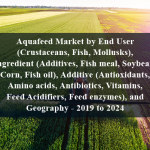OVERVIEW
The market for organic fertilizers is projected to reach USD 13.45 billion by 2024, rising at a CAGR of 11.2% during the forecast period. Increasing consumer awareness of the harmful effects of organic and natural fertilizers, pesticides and medications will provide a positive outlook for the scale of the industry. Growing consumer base for non-synthetic food, beverages, personal care and pharmaceutical products has increased demand for organic fertilizers. Raising awareness of health and safety, particularly in urban populations, will support the growth of industry.








TABLE OF CONTENT
1 Global Organic Fertilizers Market
1.1 Study Objectives
1.2 Market Definition
1.3 Study Scope
1.3.1 Markets Covered
1.3.2 Geographic Scope
2 RESEARCH METHODOLOGY
2.1 Research Data
2.1.1 Secondary Data
2.1.1.1 Key Data From Secondary Sources
2.1.2 Primary Data
2.1.2.1 Key Data From Primary Sources
2.1.2.2 Key Industry Insights
2.1.2.3 Breakdown of Primaries
2.2 Market Size Estimation
2.2.1 Bottom-Up Approach
2.2.2 Top-Down Approach
2.3 Market Breakdown and Data Triangulation
2.4 Research Assumptions
3 Global Organic Fertilizers Market – Executive Summary
3.1 Market Revenue, Market Size and Key Trends by Company
3.2 Key Trends by type of Application
3.3 Key Trends segmented by Geography
4 Global Organic Fertilizers Market – Comparative Analysis
4.1 Product Benchmarking – Top 10 companies
4.2 Top 5 Financials Analysis
4.3 Market Value split by Top 10 companies
4.4 Patent Analysis – Top 10 companies
4.5 Pricing Analysis
5 Global Organic Fertilizers Market – Industry Market Entry Scenario
5.1 Regulatory Framework Overview
5.2 New Business and Ease of Doing business index
5.3 Case studies of successful ventures
5.4 Customer Analysis – Top 10 companies
6 Global Organic Fertilizers Market – Market Forces
6.1 Introduction
6.2 Market Dynamics
6.2.1 Drivers
6.2.2 Opportunities
6.2.3 Challenges
6.3 Porters Analysis of Market
6.3.1 Bargaining power of suppliers
6.3.2 Bargaining powers of customers
6.3.3 Threat of new entrants
6.3.4 Rivalry among existing players
6.3.5 Threat of substitutes
7 Global Organic Fertilizers Market – Strategic Analysis
7.1 Value Chain analysis
7.2 Product Life Cycle
7.3 Supplier and distributor analysis (Market share and product dealing strategies)
8 Global Organic Fertilizers Market – By Source (Market Size – & million/billion)
8.1 Plant
8.2 Animal
8.3 Mineral
9 Global Organic Fertilizers Market – By Crop Type
9.1 Cereals & grains
9.2 Oilseed & pulses
9.3 Fruits & vegetables
9.4 Others
10 Global Organic Fertilizers Market – By Form
10.1 Dry
10.2 Liquid
11 Global Organic Fertilizers Market – By Geography (Market Size – &million/billion)
11.1 Introduction
11.2 North America
11.2.1 US
11.2.2 Canada
11.2.3 Mexico
11.3 Europe
11.3.1 U.K
11.3.2 Germany
11.3.3 Italy
11.3.4 France
11.3.5 Spain
11.3.6 Rest of Europe
11.4 Asia-Pacific
11.4.1 China
11.4.2 Japan
11.4.3 India
11.4.4 South Korea
11.4.5 Rest of APAC
11.5 Rest of the World
11.5.1 South America
11.5.2 Middle East
11.5.3 Africa
12 Global Organic Fertilizers Market – Entropy
12.1 New product launches
12.2 M&A’s, collaborations, JVs and partnerships
13 Global Organic Fertilizers Market Company Profile (Key Players)
13.1 Market Share, Company Revenue, Products, M&A, Developments
13.2 Tata Chemicals Limited
13.3 Italpollina SPA
13.4 The Scotts Miracle-Gro Company
13.5 Coromandel International Limited
13.6 Perfect Blend, LLC
13.7 Sustane Natural Fertilizer, Inc.
13.8 National Fertilizers Limited
13.9 Biostar Systems, LLC.
13.10 Krishak Bharati Cooperative Limited
13.11 Midwestern Bioag
13.12 Company 11 & more
14 Global Organic Fertilizers Market – Appendix
14.1 Sources
14.2 Abbreviations











